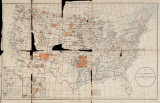| OCR Text |
Show COMMISSIONER OF INDIAN AFFAIRS. 29 Civilized Tribes. In endeavoring to persuade the Indians to clear and to farm their lands these employees have had the cooperation of the local representatives of the Department of Agriculture and of the State board of agriculture. In eastern Oklahoma the Department of Agriculture has had 31 Indian demonstrators and 235 Indian cooperators; in success and progress these Indians have equaled and in some instances have surpassed their white neigbbors. In an attempt to make each Indian child's training directly pre-paratory to the position in which he will find himself upon leaving school the superintendent at Union Agency, Okla., is furnishing the superintendents of the various schools with information about each student's lands, their fair market value and their present rental value, and the crops for which the land is most suitable; it will be the duty of the superintendents to impress upon each student some concep-tion of the value and the utility of his property and to give him some howledge about how to farm and manage his land. While there has been some industrial progress at substantially all the reservations, tentative plans must he formulated for the more rapid upbuilding and advancement at many places. This is true among the Chippewa Indians in Minnesota, the Sioux of North and South Dakota, the Mission Indians of California, the Navajo of Arizona and New Mexico, the Washoes of Nevada, and Pueblos of New Mexico, and at Campo, Camp Verde, Cheyenne =ver, Colville, Colorado River, Cherokee (North Carolina), Crow, Cushman, Digger, Fallon, Flathead, Fond du Lac, Fort Apache, Fort Belknap, Fort Bidwell, Fort Hall, Fort McDermitt, Fort Mojave, Fort Peck, Fort Yuma, Grand Portage, Raw, Keshena. Kiowa, Klamath, Lac du Flambeau, Moapa River, Navajo Springs, Neah Bay. Nevada, Otoe, Pawnee, Pipestone, Pottawatomie, Red Cliff, Red Moon, Sac and Fox (Iowa), Sac and Fox (Oklahoma), San Xavier, Seger, Senecs, San Carlos, Shawnee, Shivwits, Siletz, Southern Ute, Truxton Canon, Tulalip, Tule River, Turtle Mountain, Umatilla, Walker River, Warm Springs, Western Shoshone, Yakima, and Yankton. Super-visors are in the field investigating conditions among the Apache Indians under San Carlos and Fort Apache Schools and the Chip-pewa Indians in Minnesota, with the view to mapping out practical plans for the industrial advancement of those Indians. On February 7, 8, and 9 a conference was held at the Navajo In-dian School in Arizona for the purpose of discussing various suh-jects and problems common to all the Navajo reservations and the formulation of programs for the future upbuilding of these jurisdic-tions. The supervisors, superintendents in charge of the Navajo and adjacent reservations and schools, and a number of Indians, em-ployees, and missionaries working among the Indians in that section of the country were present. There were as many as 50 to 150 Indians |










































































































































































































































































